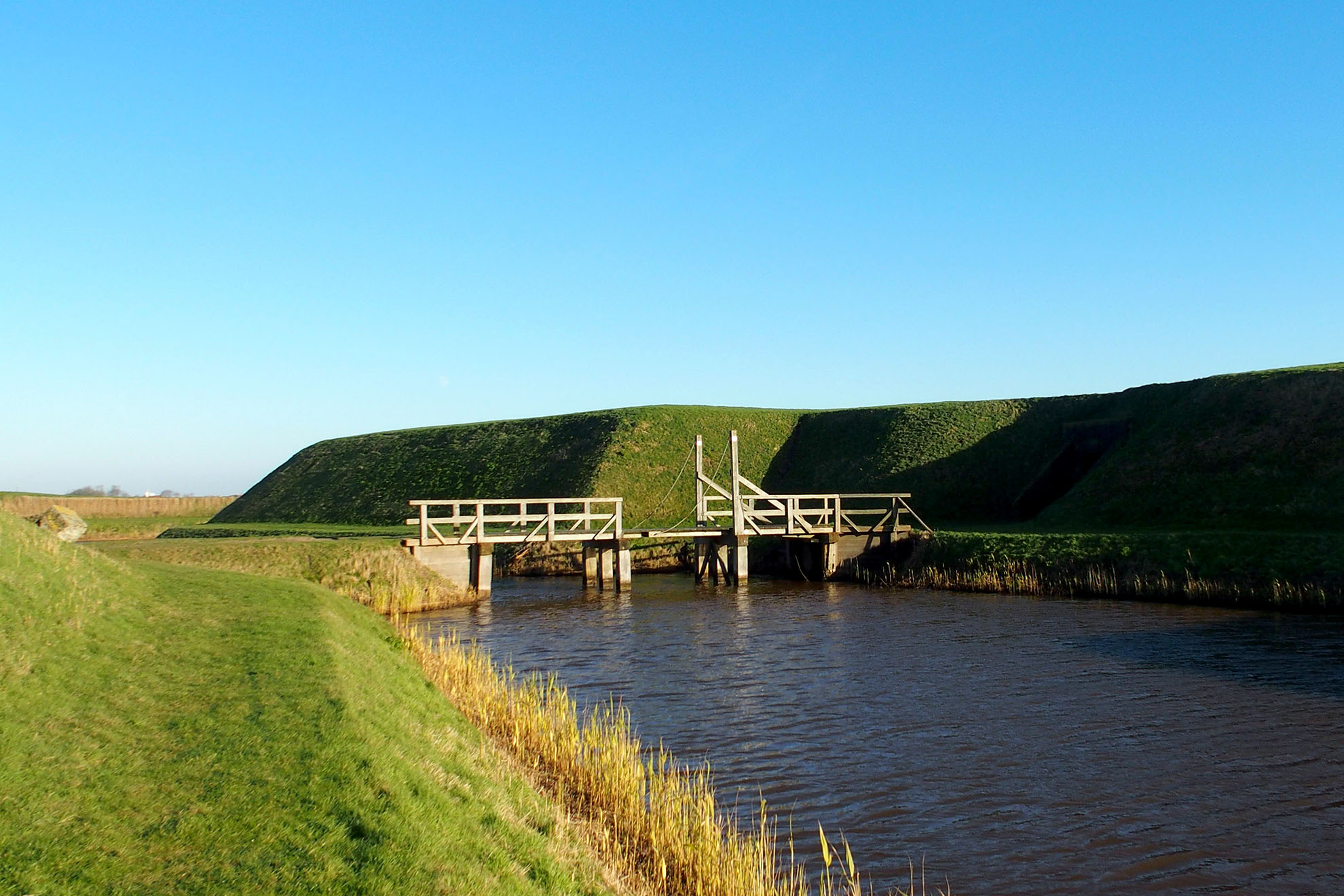Fort de Schans

Het fort de Schans is nu een oase van rust. Hier controleerden in de zestiende eeuw de watergeuzen de handelsvloot op de Reede. Later zou Napoleon het fort laten vergroten en versterken. Want de Engelsen mochten de Reede niet gebruiken als uitvalsbasis voor een invasie op het continent.
Prins tegen koning

In de zestiende eeuw was de Reede van Texel al een belangrijke ankerplaats voor de Hollandse handelsvloot. Het was het begin van de 80-jarige oorlog en veel Hollandse steden waren nog trouw aan de koning in Spanje. Met de hulp van de watergeuzen liet Willem van Oranje in 1574 aan de oostkust van Texel het Fort de Schans aanleggen. Zo kon hij de schepen van de prinsgezinde steden laten beschermen en militaire druk uitoefenen op koningsgezinde steden.
Sporen van het verleden

Ooit stonden in het fort kazernes en een woonhuis. Die zijn allemaal gesloopt. Maar de kruitkamer, een soort bomvrije opslagplaats voor munitie, is er nog wel. In de fortgracht zat ook een sluis. Die kon gebruikt worden om de omliggende polders onder water te zetten. Dan werd het fort minder goed bereikbaar vanaf de landkant.
De bloeitijd van de Reede
In het begin van de zestiende eeuw werd de Reede nog belangrijker als ankerplaats. Alle koopvaardijschepen werden voor de kust van Texel bevoorraad en bemand. Bij terugkomst werd de lading overgeslagen op kleinere vrachtschepen voor het binnenlands vervoer. Bovendien ankerden ook de oorlogsschepen van de admiraliteit op de Reede. Daarom werd het fort niet alleen in ere gehouden, maar ook regelmatig uitgebreid en versterkt.
Gevangenis

Gedurende verschillende periodes in de geschiedenis hebben de kazernes op het fort dienst gedaan als gevangenis. Het waren bij toeval meestal Engelse krijgsgevangenen die er opgesloten werden. Dat gebeurde bijvoorbeeld tijdens de Amerikaanse Onafhankelijkheidsoorlog en tijdens de Franse bezetting van Nederland.
Napoleon
De bevelhebbers van het Franse leger zagen in dat het Marsdiep van groot strategisch belang was voor de verdediging van de Franse republiek en zijn vazalstaten. Dat was wel duidelijk toen de Engelsen in 1799 bij Callantsoog, niet ver van Texel, een gevoelige invasie hadden uitgevoerd. De Engels-Russische troepen veroverden toen gemakkelijk een groot deel van Noord-Holland. Zij gaven zich pas over na aan aantal bloedige veldslagen en inzet van een grote Franse overmacht. Al snel ontwierpen de Fransen vele nieuwe vestingwerken, ook voor Texel. Napoleon gaf uiteindelijk de opdracht om Fort de Schans nog sterker te maken. Ook liet hij twee hulpforten, de Lunette en de Redoute, aanleggen. In 1811 kwam hij de vorderingen hoogstpersoonlijk inspecteren.
De rust breekt aan
Niet lang na de val van Napoleon, in de slag bij Waterloo in 1815, werd Nederland een zelfstandig koninkrijk. Koning Willem I stimuleerde enorm veel economische ontwikkelingen, waaronder de aanleg van het Noordhollandsch Kanaal. Toen dat in 1824 in gebruik werd genomen, betekende dat het einde van de Reede als ankerplaats. De zeegaande vrachtschepen konden immers via het kanaal naar Amsterdam worden gesleept. Fort de Schans bleef nog een tijdje bemand, maar rond 1850 werd de militaire functie opgeheven. Na het afbreken van de gebouwen trad het verval in.
Een plak van het fort

Aan de westkant van het fort zie je nog de geometrische opbouw zoals die door de ingenieurs van Napoleon bedacht is, met bolwerken en een dubbele fortgracht. Aan de oostkant van het fort ontbreekt dit patroon. Het is er wel geweest, maar het lijkt net alsof iemand een flinke plak van het fort heeft afgesneden. In zekere zin is dat ook zo. De oorspronkelijke oostelijke fortwallen werden rond 1930 afgegraven. Met het zand werden de dijken opgehoogd. En in 1973 werd de waddendijk op Deltahoogte gebracht. De verhoogde dijk kwam zo ver landinwaarts dat het oostelijke deel van de buitenste fortgracht moest worden gedempt.
Restauratie
Vanaf het einde van de jaren ’90 is het fort in beheer van Natuurmonumenten. Toen is een restauratie ingezet om zo veel mogelijk van de situatie van 1813 te herstellen. De grachten zijn uitgediept, de wallen waar nodig hersteld. Ook de bruggen en de toegangspoort zien er weer uit zoals Napoleon zich dat voor zich zag.
Toegankelijk

Fort de Schans is open voor wandelaars. Een dam en een loopbrug verschaffen toegang tot het hart van het fort. Met een beetje fantasie kun je daar 450 jaar geschiedenis opsnuiven. Museum Kaap Skil organiseert excursies naar het fort voor groepen.








